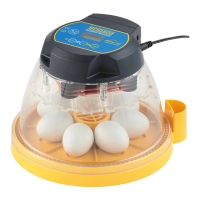
Do you have a question about the Brinsea Mini II Advance Mini II Advance and is the answer not in the manual?
| Egg Turning | Automatic |
|---|---|
| Category | Egg Incubator |
| Function | Egg Incubation |
| Capacity | 7 eggs |
| Compatibility | Chicken, duck, quail, and other small bird eggs |
| Material | Plastic |
Explains the importance and control of humidity in egg incubation.
Explains RH as a measure of water vapor in air compared to maximum capacity.
Describes wet bulb temperature and its relation to humidity measurement.
Shows a graph of egg weight loss to monitor incubation humidity.
Details how to adjust humidity levels by modifying water surface area and ventilation.
Outlines five temperature zones and their impact on embryo development.
Describes development issues caused by temperatures between 27-35°C.
Explains the temperature range where embryonic development is suspended.
Details the temperature threshold leading to ice crystal formation and damage.
Short cooling periods have no detrimental effect and may be beneficial.
Long cooling depends on development stage, with specific temperature ranges recommended.
Addresses power loss during the critical hatching phase and how to mitigate damage.
Warns against prolonged exposure to temperatures causing disproportionate development.
Advises against excessive temperatures, especially in early incubation.
